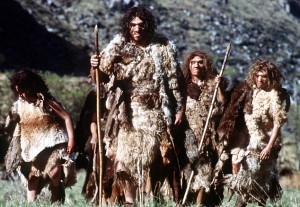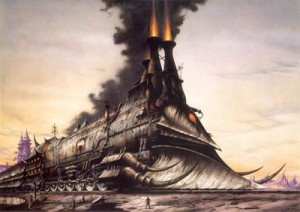We’re at a weird time in our species’ history but anyone with teenagers recognizes it instantly. You go from being a kid where everything is bigger and more powerful than you to having an unprecedented amount of control over the world. And it’s not until a few years later when, as an adult, you realize, “holy crap, what an illusion that was. It’s a miracle I survived.”
Really the whole early history of humans and civilization is about managing or at least coming to terms with big things that can kill you. Unlike most of our fellow mammals, our bodies are under equipped as far as animals go. Put a naked human being next to a bear or a tiger [editor’s note: don’t actually do this] or even an otter or a rabbit and you get a sense of how helpless are. No claws, no fur, not especially fast, not a particularly great sense of smell, of the entire animal kingdom our offspring are the worst helpless idiots and for years. What other species young would willingly walk off a cliff or eat a poisoned berry unless watched and cared for constantly?
I imagine a saber toothed tiger chilling with a cave bear at the base of some glacier a few hundred thousand years ago. They’re gnawing on some bones and just swapping predator talk while watching a rag-tag band of early humans struggle by in the mud of the effluvial outwash. The tiger points with his paw and says:
“Will you look at those things? Hobbling around on just the two back legs, covered in preyskins because they can’t even grow their own fur. They’re slow, they’re loud, they are clumsy as hell and it takes like 10 of them to bring down a mammoth. Pathetic, really.”
The bear nods his head and then after a second says,
“Yeah, but have you seen that fire shit they do?”
Fast forward to the present day and the only physical memory of both of their species is a drawer in a museum and the place where they were chatting is now a moped dealership.
I firmly believe that if human beings had any decent innate tools at all to fight against our early predators besides intelligence we would never have gotten past the “sharp stick” phase of technological development. We develop tools and ideas to protect us from big things that can kill us.
But somehow, in the teen years of our species, before we really know what the hell is going on and are just reacting to the day-to-day, we’re confused about the big things that can kill us. For all our knowledge and technology, most of us are just really bad at pointing out and avoiding the most obviously dangerous things.
Usually when someone makes this point they start talking about auto crashes or heart disease, but I want to spend a minute thinking about trains. Yes, trains, our relationship to trains is more indicative of the problem at hand, I think than cars which for their danger are incredibly useful or fatty foods, which our brains are actually programmed to want.
Trains have been around for a century and a half. One can easily predict where a train won’t be, and even predicting where one will be is limited to a highly defined area called “train tracks.” If you are not on train tracks, which when you think about it are pretty small comparatively, you will not be hit by a train. It’s that simple. Yet people are killed by trains all the time and engage in all kinds of risky behaviors around them.
I commute by train when I go into Boston and have done so for years. You would not believe all the dumbassery that takes place around trains (and I’m not talking about the incredibly sad cases of folks who’ve actively chosen to end their lives this way). People step in front of them, they walk along the tracks, they drive across the tracks when the train is coming and I once even saw a dude go under the train as it was leaving Gloucester so he could get to McDonalds that much quicker, saving him the time of having to wait for all seven cars to pass.
This woman in New York last week who caused an accident that killed five people had stopped to check her car because it had clipped one of the crossing signals. All the details are not out, but it looks like she leapt back into her car and drove even further into the path of the train, maybe with the car in the wrong gear? You’d think she wasn’t trying to gun it across, but in my time as a rail commuter I’ve been on trains that have hit cars on three separate occasions.
Even more unclear on the concept of Newtonian physics was the guy who jumped off the train in Lynn when he realized it was express to Salem and not stopping there. We were stopped for hours and hours as they investigated the scene and the poor bastard ended up losing an arm. When we finally got moving the conductor shook his head and said, “He risked his life to get INTO Lynn? I just don’t get it.”
So why can’t a too-large portion of the population come to grips with the fact that trains are dangerous while at the same time freaking out over things like ebola, which obviously aren’t? I think it’s familiarity. I think if things are too common we forget to be afraid of them. A friend works in an elementary school in Essex where they routinely practice lockdown drills in case of an armed intruder. This is wise and desperately sad, but the shootings are so uncommon that there is not much else you can do. Sealing the place up like Masada is going too far. At the same time, you may not know this, but Essex Massachusetts is currently under a plague of rabid skunks. Read their police notes, it’s like the frikin zombie skunk apocalypse over there. I’m an outdoorsy person, I have an overly-curious collie, I walk in Essex sometimes and the stink-monsters from Hell are far more dangerous to creatures I love and all those kids on that playground than some loon with a gun, who is indeed dangerous but just not common.
We take the common dangers in stride, push them away and habituate ourselves. We append no risk to the boring or the mundane. The snowstorm has to be sold as a howling death fury to get our attention. By March even blizzards will probably fail to get a reaction and they will start giving them dull names. Winter storm “Sheldon”, snow event “Ed.” Maybe to be scared we need a little drama and hype, maybe to take precaution we require some pizzaz. Local media does it with storms, maybe we can get Fox 25 to do a “Deathtrain Watch” or we could combine two boring things together to make them a more exciting and therefor more avoidable threat.
Strap rabid skunks to the front of the trains, is what I’m saying. It’s the obvious solution.






Ancient railroad accident story: My great great grandfather Jimmy Curtis (about whom I’m sort of writing a book if I can ever get enough primary source material — it’s pretty thin) was killed by a train in 1839. He was the Boston & Worcester RR (later Boston & Albany, now Amtrak) superintendent, sort of inventing railroading as he went along (hey, cross-ties would be a good idea; maybe we won’t have all those derailments when the tracks get separated; hey, how about a cowcatcher to clear cattle off the tracks; how about headlights instead of a bonfire on a flatcar ahead of the locomotive? He invented a spark arrester — Andrew Jackson signed the patent — because passengers riding on top of passenger cars (men on top, ladies inside) complained that their clothes were always catching fire from sparks pooping out the smokestack ahead of them). A big rainstorm hit Boston on April 12, 1839; next morning he went down to the depot (about where the South Station is now) to have an inspection train set up so he could check to make sure the roadbed hadn’t washed out. Just as the train passed under Washington Street he stuck his head out to look down, and it struck an iron bridge support. He was knocked back into the car where he fell dead.
So bizarre railroad accidents have a long history. Incidentally, after they investigated the cause of the accident, city officials decided that killer bridge support was unnecessary, and had it removed.